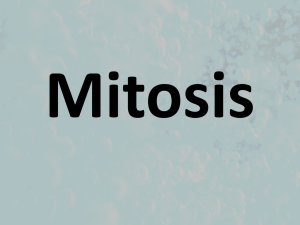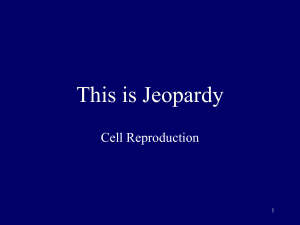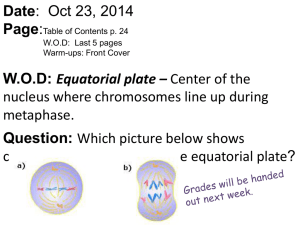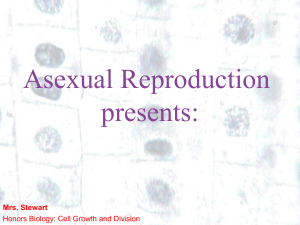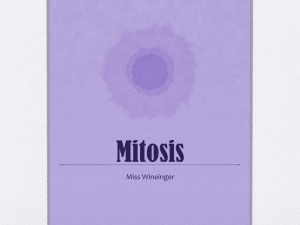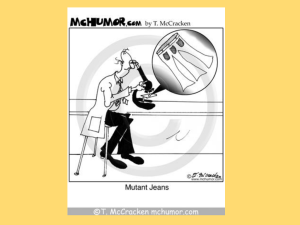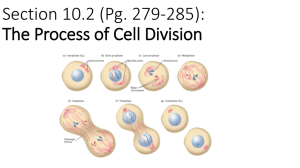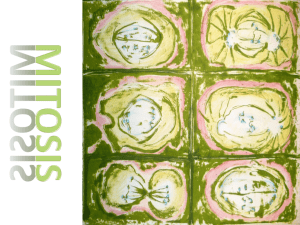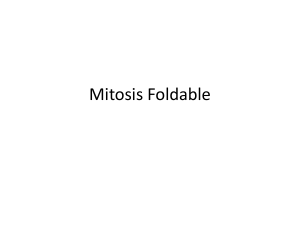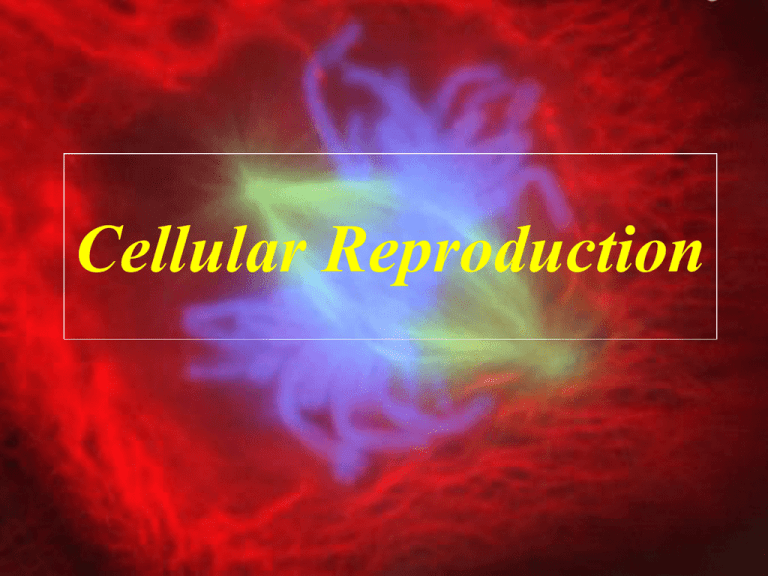
Cellular Reproduction
Why Cells Reproduce/Divide
• Growth
• Cell Repair
• Cell Replacement
Why do cells multiply and not just grow
bigger?
1. DNA overload:
-the DNA can handle only so many requests for
‘information’
ex: library in growing town
2. Exchange of materials:
-the cell must have enough surface area (cell
membrane) to transport waste and nutrients
into/out of cell
-cells need HIGH surface area to volume ratio
Ratio of Surface Area to Volume in Cells
3:1
2:1
-if a cell gets too large, it is difficult to get
sufficient amounts of oxygen and nutrients in
and out of cell
-this is why cells do not grow much even if
the organism they are a part of does
-before it gets too large, a growing cell
divides forming two daughter cells
-called cell division
-before the cell divides, it replicates(copies)
all of its DNA
-helps with information b/c each daughter cell
gets its own genetic info
Chromosomes
-carry genetic info
-condensed form of DNA and protein
-only visible during cell division b/c they
come together
-are copied before cell division to get two
sister chromatids
-chromatids are attached by centromeres
-most human cells have 46 chromosomes
(each with 2 sister chromatids)
-a duplicated chromosome has two sister
chromatids which become divided during
mitosis and are distributed to each daughter
cell
Cell Cycle
-the series of events that cells go through as
they grow and divide into two daughter cells
-occurs in all cells (except sex cells)
-every 20 hours in humans
Phases of the Cell Cycle
INTERPHASE
-longest phase of the cell cycle
*G1: cell growth/making of organelles
*S: chromosomes are copied to prep for
mitosis (DNA replication)
*G2: making of more organelles in prep
for M phase, shortest phase of
interphase
CELL DIVISION
*M: division of the nucleus (mitosis)
and the cytoplasm (cytokinesis) occurs
-made up of five total steps
Interphase
-longest part of the cell cycle
-3 distinct parts G1, S, G2
-cell increases in mass
-number of organelles doubles
-DNA is duplicated
Interphase looks like:
• Nucleus and nucleolus visible.
chromatin
nuclear
membrane
cell membrane
nucleolus
chromosomes (unduplicated) in
parent cell at interphase
Maintaining
Chromosome
Number
same chromosomes
(duplicated) in interphase
prior to mitosis
mitosis, cytoplasmic division
chromosome
(unduplicated)
in daughter cell
at interphase
chromosome
(unduplicated)
in daughter cell
at interphase
Mitosis – Division of the nucleus
Made up of 4 smaller phases:
1. Prophase
2. Metaphase
3. Anaphase
4. Telophase
*can last from a few minutes to
a few days
Prophase
• longest of the 4 stages
(50% of the time)
• nucleus and nucleolus
disappear
• chromosomes become
visible
• centrioles appear and
separate
• spindle fibers gap the
space in between the two
centrioles
The Spindle Fibers
-a web type structure made up of microtubule
fibers
-is essential for mitosis because it arranges the
chromosomes into their correct positions to prep
for cell division.
Mitotic centre
A cell at metaphase
Microtubule
a spindle
Metaphase
• shortest phase (only a
few minutes)
• chromosomes line up
along the center of the
cell
• centromeres attach to
spindle fibers
Anaphase
• centromeres split
• chromatids move
towards the separate
poles (centrioles)
Telophase
• chromosomes
become invisible
again
• 2 distinct nuclei
form
CYTOKINESIS: the separation of the
cytoplasm between the two daughter cells
• begins during anaphase and
usually extends past
• animal cells:
-membrane pinches in
on both sides until they
meet in the center
• plant cells:
-a cell plate forms
(becomes new cell wall)
Animal Cell Division
Plant Cell Division
cell wall
former
spindle
equator
cell plate
vesicles
converging
REVIEW:
Mitosis
Mitosis Part One
Mitosis Continued
Mitosis Song
Cell Division Regulation:
• internal regulators: determine when phases occur
ex: cyclin protein
• external regulators: respond to events outside cell
ex: hormones
• uncontrolled growth is known as cancer
Meiosis
-a process of reduction division in which the
number of chromosomes per cell is cut in half
through the separation of homologous
chromosomes in a diploid cell
homologous pairs- each chromosome set has
one from male and one from female parent
diploid- has both sets of homologous
chromosomes
haploid- has one set of chromosomes
diploid (2N)
haploid (N)
diploid = full set of chromosomes
haploid = half set of chromosomes
-meiosis produces 4 haploid gamete cells
from one diploid cell
gametes cells- sex cells (egg and sperm)
-two rounds of cell division in meiosis
-this is how the amount of chromosomes gets
cut in half
-homologous chromosomes are separated
Meiosis I
-first round of division
-homologous chromosomes separated
Meiosis II
-second round of division
-chromosome number cut in half
MEIOSIS I and II
MEIOSIS I
-similar to mitosis:
*cell prepares for division
*DNA is replicated
BUT:
*homologous chromosomes pair up
*form a tetrad- made up of 4
chromatids **called synapsis
*exchange portions of their genes
*called crossing over (this adds to
diversity)
MEIOSIS II
-no interphase II (no more DNA replication)
-very similar to mitosis
-chromosomes line up as individuals, have
already been separated from partner
-sister chromatids split
PROPHASE II
METAPHASE II
TELOPHASE II and CYTOKINESIS
During meiosis:
-chromosomes independently assort
(separation of genes during gamete formation)
-haploid gametes in men = sperm cell
-haploid gametes in women = egg cell
*other three cells (in females) are called
polar bodies
MITOSIS
MEIOSIS
-2 identical diploid cells
-4 different haploid cells
-only in asexual
reproduction
-occurs during sexual
reproduction
-allows for replacement
and growth of cells
-produces gamete cells
Meiosis

